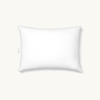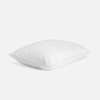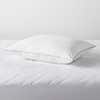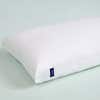How to Wash Pillows So There Are No Lumpy, Misshapen Cushions in Your Future
Plus which ones should never go in the washing machine.
Published Jun 10, 2022 1:00 PM
We may earn revenue from the products available on this page and participate in affiliate programs.
Part of exercising proper sleep hygiene means knowing how to wash pillows, and we’ve got news for you: Not all of these sleep accessories belong in the washing machine. If you’ve been taking a one-size-fits-all approach to laundering them (oops), we’ve got suggestions to tailor the job based on the filling, which will prevent them from losing their shape and ability to support your head and neck in the long run. We tapped bedding expert and EachNight contributor Malik Karman for a step-by-step guide.
Domino-approved pillows to transform your bed into a zen sleep space:
How Often to Wash Your Pillows
On average, every four to six months, as long as you cover them in a clean pillowcase. Not sure which ones can withstand the washing machine? Karman has a rule of thumb: “A pillow that can be fluffed up is machine washable.” Feather and shredded foam pillows fall under this category, but be sure to check the individual care instructions.
Extra Credit: How Often to Wash Your Pillowcases
At a minimum, weekly, but depending on your sleeping position, you may want to wash them more frequently. For instance, side and stomach sleepers tend to make more facial contact with their pillow coverings, which leads to a buildup of oils and sweat that can cause irritation and breakouts. In this case, clean your pillowcases every three days, Karman says.
How to Wash Pillows
If You Own Down, Feather, Cotton, or Poly Fiberfill Pillows…
The Supplies
- Your pillows, with pillowcases and protectors removed
- Lukewarm water
- Washing machine/dryer
- Gentle detergent (we recommend an all-natural product to keep chemicals from absorbing into the material)
- Dryer balls or sheets (optional)
Step 1: Toss Your Pillows in the Washing Machine
To avoid shrinkage and remove as much moisture as possible, select a cold-water, high-spin setting, then add a small amount of detergent into the empty washing machine drum. If you’re using a top-loading washer, place your pillows vertically; place one on either side if it’s a front-loader. Karman suggests cleaning two pillows at a time to help the machine stay balanced during the spin cycle. Avoid using liquid fabric softener, as it can cling to the down and feathers and diminish the pillow’s fluffiness. Keep in mind that king-size pillows may be too large for an in-home washer and require an industrial machine.
Step 2: Drying Time
Tumble dry the pillows on a cool or warm heat setting (not hot), and feel free to use dryer balls or a single dryer sheet to reduce static. Remove pillows from the dryer, then perform a fluff check. If they are still damp, or the material feels clumpy or smells odd (signs of lingering moisture), toss the cushions back in for another cycle.
If You Own Memory Foam or Latex Pillows…
The Supplies
- Your pillows, with pillowcases and protectors removed
- 2 clean, absorbent towels
- Lukewarm water
- Gentle detergent (we recommend an all-natural product to keep chemicals from absorbing into the material)
- Baking soda
- Vacuum with suction attachment
Step 1: Spot-Clean Any Visible Stains
Because foam soaks up excessive water, tossing them in a washing machine can cause these pillows to become backlogged and unusable. Instead, dampen a clean cloth with water and a small amount of detergent and gently dab away any visible stains on the surface, rubbing in a circular motion until they disappear.
Step 2: Set the Pillows Aside to Dry
Allow the pillows to air-dry, which could take as long as 24 hours. (To speed things up a bit, use a handheld blow-dryer on a low setting for 15 minutes per side.)
Step 3: Deodorize
Cover one side of each pillow in a thin layer of baking soda. Allow the substance to sit on the surface for a couple of hours. Use your vacuum’s suction attachment to thoroughly clear off all the baking soda remnants along with any visible lint, hair, or dirt. Repeat on the other side.
If You Own Buckwheat or Kapok Pillows…
The Supplies
- Your pillows, with pillowcases and protectors removed
- Lukewarm water
- Washing machine/dryer
- Gentle detergent (we recommend an all-natural product to keep chemicals from absorbing into the material)
- Dryer balls or sheets (optional)
- Fresh kapok hulls (optional)
Step 1: Remove the Stuffing
Manufacturers generally do not recommend machine washing or drying buckwheat or kapok pillows because they can damage the drum (also kapok pillows are naturally resistant to dust mites and moisture anyway). You can, however, launder the pillowcases. Take out the buckwheat hulls or kapok stuffing and store in a clean, dry bag. Flip the pillow shell inside out to double-check for any stragglers.
Step 2: Clean the Cases Only
Wash the coverings in cool water on a gentle cycle, then hang them up to air-dry (or if you’re in a rush, tumble dry on a low-heat setting) so they don’t shrink.
Step 3: Refill the Pillows
Load the shells with the kapok or buckwheat hulls you set aside, and feel free to add extra hulls if your pillows feel a bit light.
If You Own Microbead Pillows…
The Supplies
- Your pillows, with pillowcases and protectors removed
- Lukewarm water
- Washing machine/dryer
- Gentle detergent (we recommend an all-natural product to keep chemicals from absorbing into the material)
- Dryer balls or sheets (optional)
- A pillowcase in a like color
Step 1: Place Your Pillows Inside Pillowcases
In this instance, the pillowcases will protect your pillows from being torn or damaged by the washing machine’s agitator. Be sure to tightly knot the open end—it’ll safely contain any accidental microbead spillage.
Step 2: Wash in Cold Water
Laundering microbead pillows on their own could leave them misshapen or damaged, so toss in a few lightweight pieces of bedding like sheets or another set of pillowcases, too.
Step 3: Dry (Mostly) on a Low Setting
Keeping them inside the case, toss your pillows in the dryer on low heat. Then remove them before they’re dry all the way through—excess heat could damage the beads. Lay the pillows on a flat surface to complete the drying process. After a couple of hours, flip them over so the other side can dry.
If You Own Wool-Filled Pillows…
The Supplies
- Your pillows, with pillowcases and protectors removed
- Lukewarm water
- Washing machine/dryer
- Gentle detergent (we recommend an all-natural product to keep chemicals from absorbing into the material)
- Wool detergent
- Dryer balls or sheets (optional)
Step 1: Check the Care Instructions
Of all the types of pillows out there, these have the most prickly washing process. Some manufacturers recommend not to machine wash them at all, while others only suggest industrial appliances or those with manual controls that allow you to skip certain cycles altogether.
Step 2: Presoak the Pillows
If you have the green light, then fully submerge the pillows in lukewarm water and wool-specific detergent in the washing machine drum, allowing them to sit for 10 to 15 minutes (the machine should be off). Afterward, turn on the appliance and choose its most delicate cycle.
Step 3: Set Them Outside to Dry
Place your pillows in direct sunlight to air-dry (allow for at least a few hours), massaging them every so often to break up clumps. You also have two faster options, if you’re impatient. The first is to put the pillows in the dryer for 40 minutes on a low-heat setting to prevent clumping. Because wool is dense, however, they may require another cycle before they’re completely moisture-free. Or you can remove the filling from the covering and spread it out on a dry, flat surface in the sun while machine drying the shells on low heat.





